-
Tevatron
Milestones 1983-2011
-
Early
Milestones
Early events and milestones that helped make the Tevatron possible.
-
March
18
1983
Installation of the last of 774 superconducting magnets for the Tevatron.
-
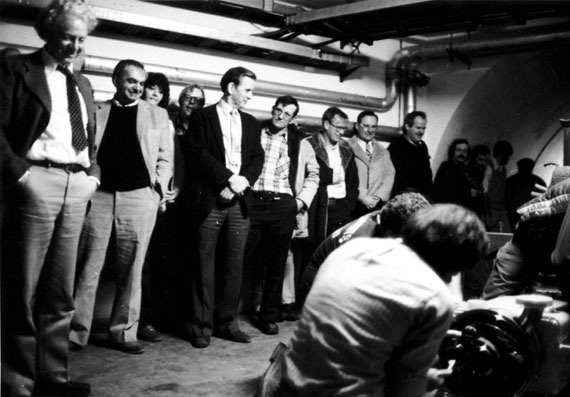 Installation of the final magnet into the Energy Doubler, March 1983. In the background are Leon Lederman, Dick Lundy, and Andy Mravca. Photo: Fermilab History and Archives Project
Installation of the final magnet into the Energy Doubler, March 1983. In the background are Leon Lederman, Dick Lundy, and Andy Mravca. Photo: Fermilab History and Archives Project
-
July
3
1983
Tevatron accelerates protons to world record energy of 512 GeV.
-
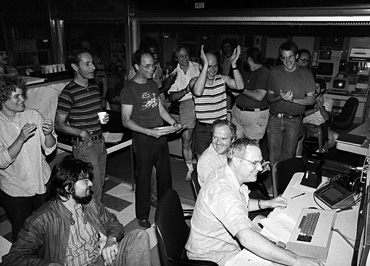 The Main Control Room at the exact moment the Tevatron accelerated protons to 512 GeV, a new world record.Photo: Fermilab History and Archives Project
The Main Control Room at the exact moment the Tevatron accelerated protons to 512 GeV, a new world record.Photo: Fermilab History and Archives Project
-
August
16
1983
Groundbreaking for Antiproton Source.
-
 Construction begins for the Antiproton Source, 1983. Photo: Fermilab History and Archives Project
Construction begins for the Antiproton Source, 1983. Photo: Fermilab History and Archives Project
-
October
1
1983
Start of the Tevatron fixed-target program at 400 GeV with five fixed-target experiments.
-
-
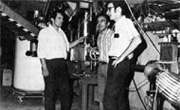 Internal Target. Photo: Fermilab History and Archives Project
Internal Target. Photo: Fermilab History and Archives Project
-
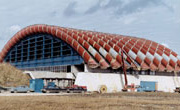 Meson Area. Photo: Fermilab History and Archives Project
Meson Area. Photo: Fermilab History and Archives Project
-
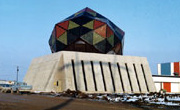 Neutrino Area. Photo: Fermilab History and Archives Project
Neutrino Area. Photo: Fermilab History and Archives Project
-
 Proton Area. Photo: Fermilab History and Archives Project
Proton Area. Photo: Fermilab History and Archives Project
-
-
February
16
1984
Acceleration of Tevatron beam to 800 GeV.
-
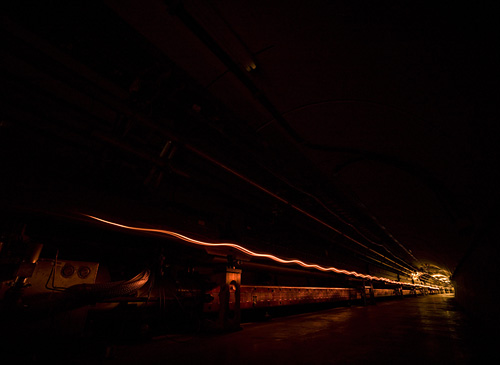 An artistic image depicts the acceleration of particle beams in the Tevatron tunnel. Photo: Reidar Hahn
An artistic image depicts the acceleration of particle beams in the Tevatron tunnel. Photo: Reidar Hahn
-
September
6
1985
Antiproton Source produces and collects first antiprotons.
-
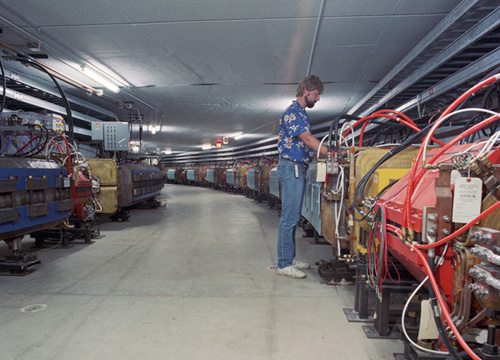 Elvin Harms in the Antiproton Source in 1989. Image: CDF
Elvin Harms in the Antiproton Source in 1989. Image: CDF
-
October
13
1985
First observation of proton-antiproton collisions by CDF collider detector at 1.6 TeV.
-
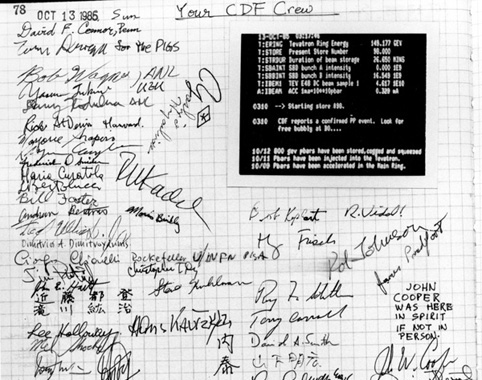 Names of CDF crew on October 13, 1985, when first proton-antiproton collisions were detected. Photo: Fermilab History and Archives Project
Names of CDF crew on October 13, 1985, when first proton-antiproton collisions were detected. Photo: Fermilab History and Archives Project
-
May
1986
Tevatron named one of the Top Ten Engineering Achievements of the Last 100 Years.
-
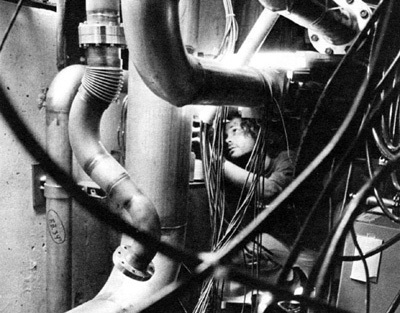 Dale Durham fits pipes in the Main-Ring tunnel for what would eventually become the Tevatron. This photograph shows the often cramped conditions that are typical of many jobs performed in the close confines of the tunnel. Photo: Fermilab History and Archives Project
Dale Durham fits pipes in the Main-Ring tunnel for what would eventually become the Tevatron. This photograph shows the often cramped conditions that are typical of many jobs performed in the close confines of the tunnel. Photo: Fermilab History and Archives Project
-
October
21
1986
Acceleration of Tevatron beam to 900 GeV.
-
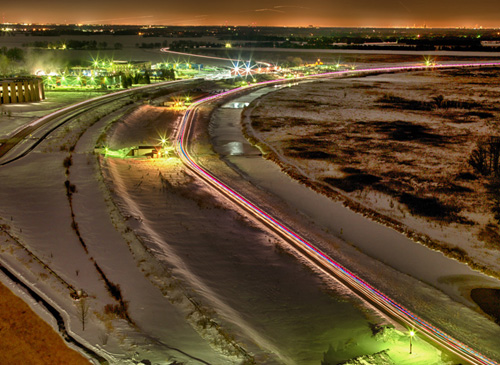 Vehicles with lights circle the Tevatron ring at night. Photo: Reidar Hahn
Vehicles with lights circle the Tevatron ring at night. Photo: Reidar Hahn
-
November
30
1986
First proton-antiproton collisions at 1.8 TeV.
-
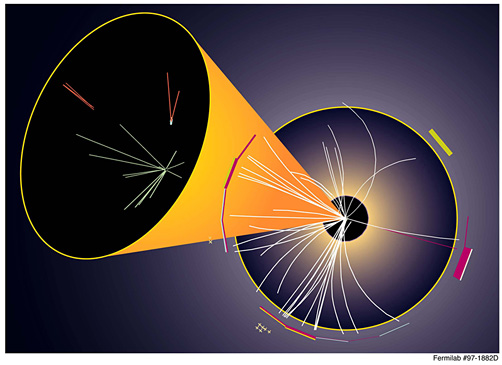 This artistic image depicts a particle collision in the CDF experiment at Fermilab from the Tevatron's Run I. The image, created in 1997, shows a pair of top quark events decaying into a W boson and b quark. The pink tower in the wide view identifies a positron from W decay; the inset shows displaced decays of two b particles (red tracks). Image: KerrCom Multimedia
This artistic image depicts a particle collision in the CDF experiment at Fermilab from the Tevatron's Run I. The image, created in 1997, shows a pair of top quark events decaying into a W boson and b quark. The pink tower in the wide view identifies a positron from W decay; the inset shows displaced decays of two b particles (red tracks). Image: KerrCom Multimedia
-
October
18
1989
Helen Edwards, Dick Lundy, Rich Orr and Alvin Tollestrup receive the National Medal of Technology for their work in building the Tevatron.
-
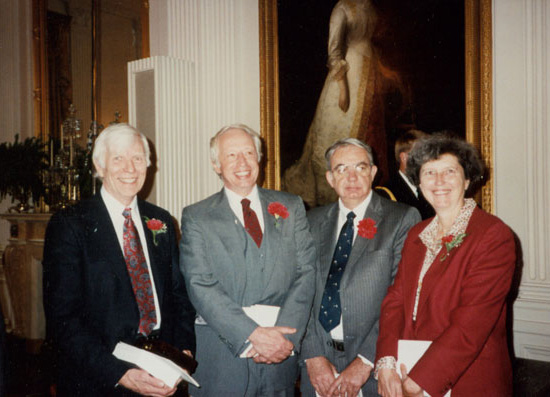 1989 National Medal of Technology recipients: (left to right) Alvin V. Tollestrup, J. Ritchie Orr, Richard A. Lundy and Helen T. Edwards. Photo: Fermilab History and Archives Project
1989 National Medal of Technology recipients: (left to right) Alvin V. Tollestrup, J. Ritchie Orr, Richard A. Lundy and Helen T. Edwards. Photo: Fermilab History and Archives Project
-
August
1991
First 8MM tape (2.5 GB) used to record data from a particle physics experiment
-
 Storage for the data accumulated by experiments at the Tevatron
evolved from tens of Terabytes on tape to the current storage of 18
Petabytes with transfers of over 60 Terabytes to and from automated tape
libraries on the average day. Image: Reidar Hahn
Storage for the data accumulated by experiments at the Tevatron
evolved from tens of Terabytes on tape to the current storage of 18
Petabytes with transfers of over 60 Terabytes to and from automated tape
libraries on the average day. Image: Reidar Hahn
-
May
12
1992
DZero detector observes first proton-antiproton collisions.
-
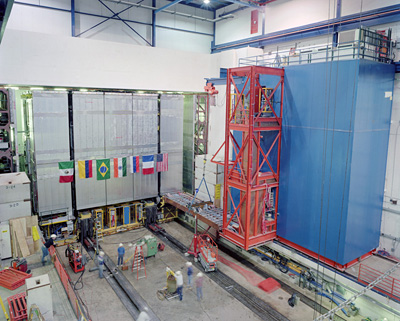 The DZero detector in the collision hall in February of 1992. Photo: Reidar Hahn
The DZero detector in the collision hall in February of 1992. Photo: Reidar Hahn
-
August
31
1992
Collider Run I physics program begins with proton-antiproton collisions at 1.8 TeV
-
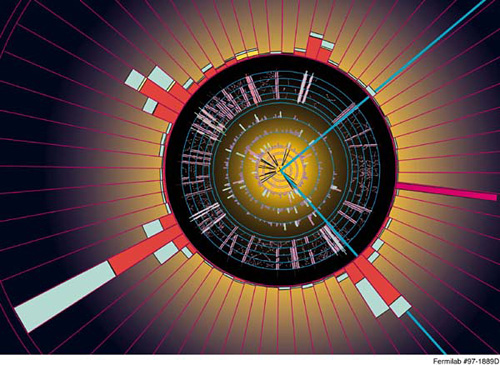 A display of a particle collision event from the Tevatron's Run I. This particle collision event, created in 1997, shows a pair of top quarks reconstructed in the DZero experiment at Fermilab. This end view shows the final decay products: two muons (turquoise), a neutrino (pink), and four jets of particles. Image: KerrCom Multimedia
A display of a particle collision event from the Tevatron's Run I. This particle collision event, created in 1997, shows a pair of top quarks reconstructed in the DZero experiment at Fermilab. This end view shows the final decay products: two muons (turquoise), a neutrino (pink), and four jets of particles. Image: KerrCom Multimedia
-
September
27
1993
Tevatron's cryogenic cooling system is named International Historic Mechanical Engineering Landmark by the American Society of Mechanical Engineers.
-
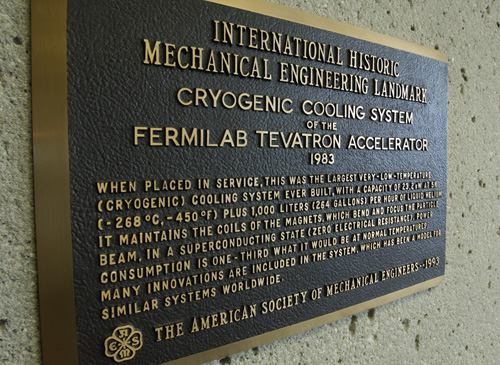 Mechanical Engineering Landmark plaque, Last Magnet Installed Document and Cross Section of Tevatron Dipole Magnet Photo: Deborah Guzman
Mechanical Engineering Landmark plaque, Last Magnet Installed Document and Cross Section of Tevatron Dipole Magnet Photo: Deborah Guzman
-
February
2
1995
Tevatron sets world record for number of high-energy proton-antiproton particle collisions.
-
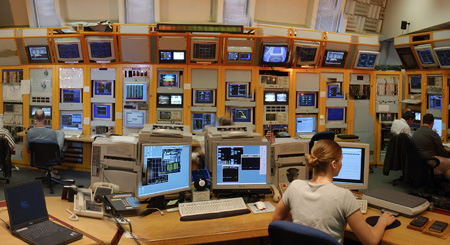 Operators in the Main Control Room work around the clock to run the collider. Photo: Reidar Hahn
Operators in the Main Control Room work around the clock to run the collider. Photo: Reidar Hahn
-
March
3
1995
Experimenters of the CDF and DZero collaborations announce discovery of top quark.
-
 Headlines about the top quark discovery from around the world. Photo: Reidar Hahn
Headlines about the top quark discovery from around the world. Photo: Reidar Hahn
-
February
20
1996
End of Collider Run I. The Tevatron has delivered 180 inverse picobarns to both CDF and DZero.
Learn more(PDF)
-
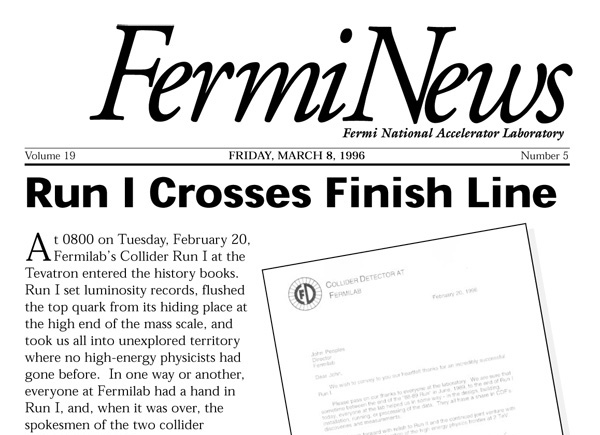 A FermiNews article about the end of Run I. Image: FermiNews, March 8, 1996
A FermiNews article about the end of Run I. Image: FermiNews, March 8, 1996
-
November
18
1996
Observation of antihydrogen atoms and exotic charm meson states in antiproton experiments.
-
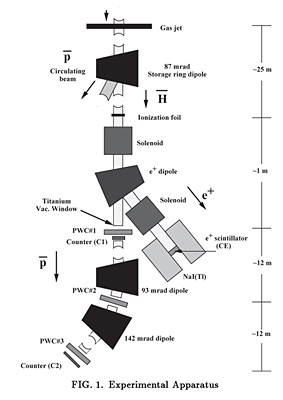 This experimental apparatus was used in experiment number 862, which detected antihydrogen atoms in 1997. Image: PPD, Fermilab
This experimental apparatus was used in experiment number 862, which detected antihydrogen atoms in 1997. Image: PPD, Fermilab
-
August
5
1997
The Tevatron delivers a record intensity 800 GeV beam for fixed-target experiments: 2.86 x 1013.
-
 A FermiNews article from Aug. 15, 1997. Image: FermiNews, Aug. 15, 1997
A FermiNews article from Aug. 15, 1997. Image: FermiNews, Aug. 15, 1997
-
March
5
1998
Discovery of Bc meson, the last of the quark-antiquark pairs known to exist.
Learn more(PDF)
-
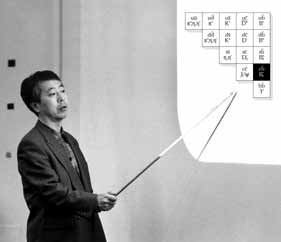 Tsukuba University physicist Shin-Hong Kim, of CDF, discussed the discovery of a new meson at a Fermilab seminar on March 5, 1998. Photo: Reidar Hahn/FermiNews
Tsukuba University physicist Shin-Hong Kim, of CDF, discussed the discovery of a new meson at a Fermilab seminar on March 5, 1998. Photo: Reidar Hahn/FermiNews
-
August
1998
First version of Fermi Linux, the operating system that enabled Fermilab to build large physics data analysis clusters using commercially available computers.
-
 Fermi Linux, a special distribution of the Linux operating
system, was originally created for use by Fermilab experiments.
Scientific Linux, which is produced at Fermilab,now runs on tens of
thousands of machines and is the operating system that powers some of
the worldís largest physics experiments, including some experiments at
the Large Hadron Collider. Image: Reidar Hahn
Fermi Linux, a special distribution of the Linux operating
system, was originally created for use by Fermilab experiments.
Scientific Linux, which is produced at Fermilab,now runs on tens of
thousands of machines and is the operating system that powers some of
the worldís largest physics experiments, including some experiments at
the Large Hadron Collider. Image: Reidar Hahn
-
March
1
1999
Fixed-target experiment KTeV observes direct CP violation in the decay of neutral kaons.
-
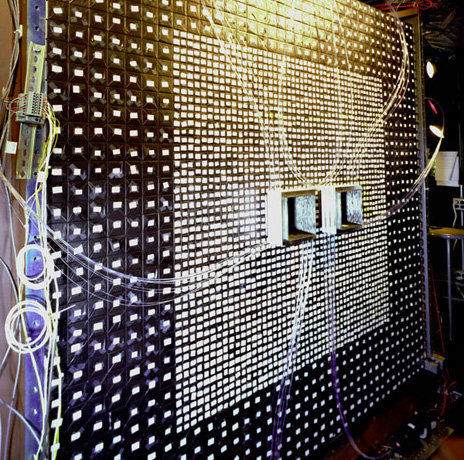 Cesium iodide crystal stacking for the KTeV experiment. Photo: Reidar Hahn
Cesium iodide crystal stacking for the KTeV experiment. Photo: Reidar Hahn
-
January
2000
End of the Tevatron fixed-target program, which provided beam to 43 experiments.
-
 The cover design of a commemorative book celebrating the Tevatron's fixed-target program. Illustration: Angela Gonzales
The cover design of a commemorative book celebrating the Tevatron's fixed-target program. Illustration: Angela Gonzales
-
July
20
2000
The DONuT experiment reports first evidence for the direct observation of the tau neutrino.
-
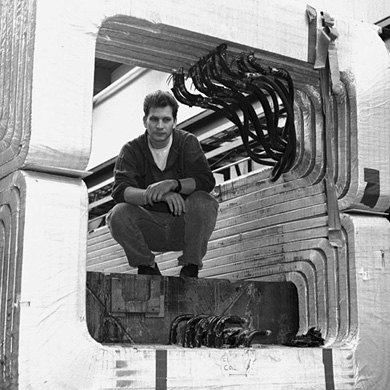 DONUT spokesman Vittorio Paolone, University of Pittsburgh, poses inside the magnet used to eliminate charged particles from the neutrino beam. The tau neutrino is the third kind of neutrino known to particle physicists. Photo: Fermilab History and Archives Project
DONUT spokesman Vittorio Paolone, University of Pittsburgh, poses inside the magnet used to eliminate charged particles from the neutrino beam. The tau neutrino is the third kind of neutrino known to particle physicists. Photo: Fermilab History and Archives Project
-
March
1
2001
Tevatron collider Run II begins after successful completion of experiment, computing and facility upgrades.
-
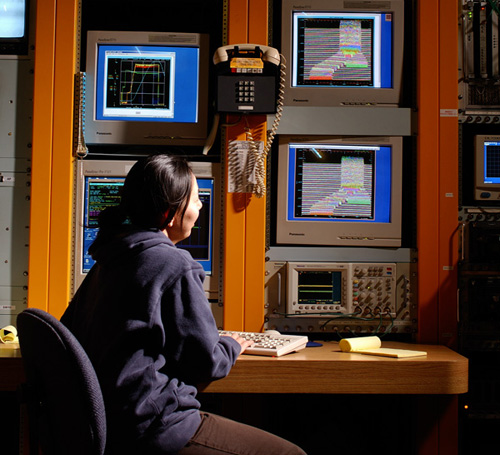 Postdoc Kiyomi Seiya in the Main Control Room. Seiya worked on the RF system for slip stacking, a process that doubled the number of protons hitting a target, one of many systems upgraded for the Tevatron's second run. Photo: Reidar Hahn
Postdoc Kiyomi Seiya in the Main Control Room. Seiya worked on the RF system for slip stacking, a process that doubled the number of protons hitting a target, one of many systems upgraded for the Tevatron's second run. Photo: Reidar Hahn
-
November
7
2001
NuTeV makes precision measurements of weak interaction parameters.
-
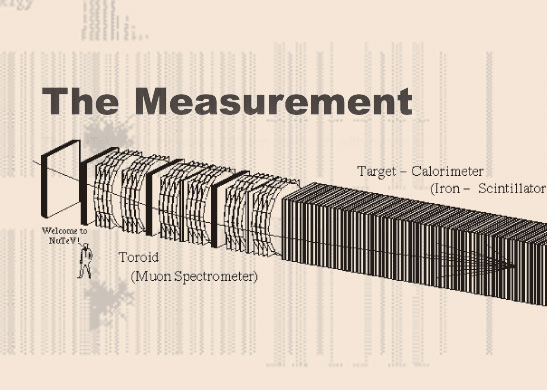 The NuTeV detector was a 700-ton sandwich with over a hundred slices of alternating steel and particle detectors. Even with 700 tons of target material to hit, only one in a billion neutrinos in the NuTeV beam interacted as it went from the first to the last slice. Image: NuTeV
The NuTeV detector was a 700-ton sandwich with over a hundred slices of alternating steel and particle detectors. Even with 700 tons of target material to hit, only one in a billion neutrinos in the NuTeV beam interacted as it went from the first to the last slice. Image: NuTeV
-
July
16
2004
Tevatron achieves a peak luminosity of 1x 1032 cm-2 sec-1.
-
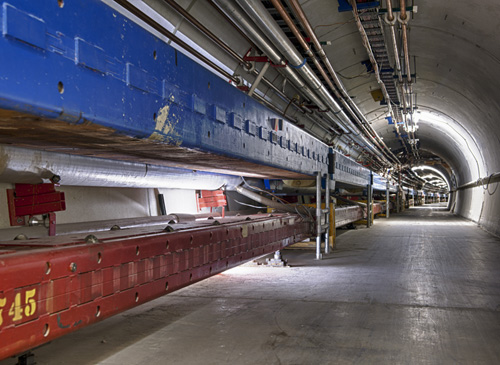 Luminosity is the measure of the number of particle collisions that occur each second. Increasing the number and rate of collisions was the Tevatron's path to discovery. To increase the number of collisions, accelerator experts tried to maximize the peak luminosity, or initial number of protons and antiprotons, of each store to the Tevatron. Image: Reidar Hahn
Luminosity is the measure of the number of particle collisions that occur each second. Increasing the number and rate of collisions was the Tevatron's path to discovery. To increase the number of collisions, accelerator experts tried to maximize the peak luminosity, or initial number of protons and antiprotons, of each store to the Tevatron. Image: Reidar Hahn
-
June
22
2005
FOCUS experiment completes comprehensive studies of charm mesons and baryons.
-
 Focus collaboration meeting in Colorado, June 2003. Photo: Focus collaboration
Focus collaboration meeting in Colorado, June 2003. Photo: Focus collaboration
-
July
9
2005
First observation of electron cooling of antiprotons in the Recycler Ring.
-
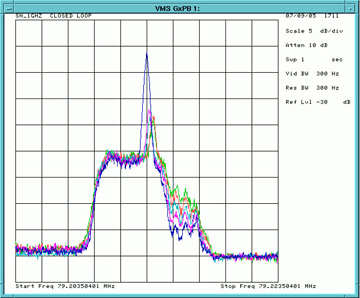 This electronic log from 2005 indicates the first interactions between electrons and antiprotons in Fermilab's electron cooling system. Image: Electron cooling system staff
This electronic log from 2005 indicates the first interactions between electrons and antiprotons in Fermilab's electron cooling system. Image: Electron cooling system staff
-
September
9
2006
Tevatron achieves a peak luminosity of 2x 1032 cm-2 sec-1.
-
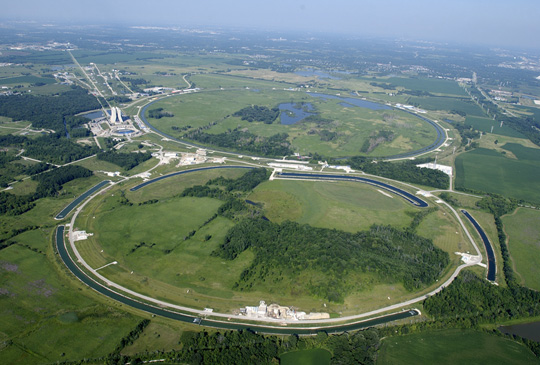 An aerial photo of the Fermilab site from 2006. Photo: Reidar Hahn
An aerial photo of the Fermilab site from 2006. Photo: Reidar Hahn
-
September
25
2006
Discovery of Bs matter-antimatter oscillations: 3 trillion times per second.
-
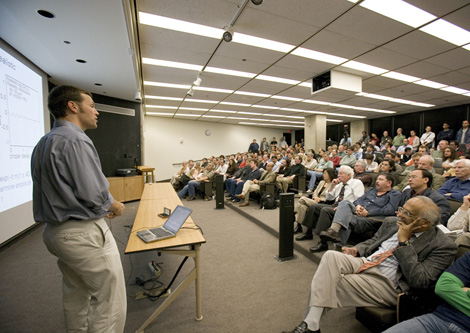 CDF collaborator Christoph Paus announced the discovery of B_s antimatter oscillations at a Wine & Cheese seminar on Friday, Sept. 25, 2006. Photo: Reidar Hahn
CDF collaborator Christoph Paus announced the discovery of B_s antimatter oscillations at a Wine & Cheese seminar on Friday, Sept. 25, 2006. Photo: Reidar Hahn
-
October
23
2006
Discovery of Sigmab baryons (up-up-bottom and down-down-bottom quark combinations).
-
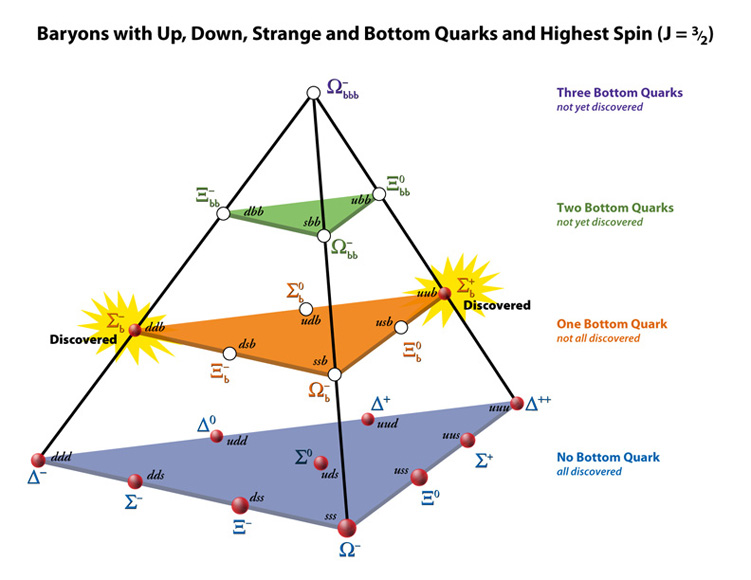 The CDF experiment discovered the positively charged Sigma-sub-b and the negatively charged Sigma-sub-b in both spin configurations. Image: Fermilab
The CDF experiment discovered the positively charged Sigma-sub-b and the negatively charged Sigma-sub-b in both spin configurations. Image: Fermilab
-
June
2007
Discovery of the Cascade-b baryon (down-strange-bottom combination).
-
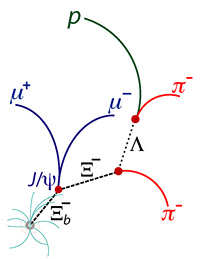 In 2007, the CDF and DZero collaborations had back-to-back discoveries of the cascade b-baryon, which is made of a down, a strange and a bottom quark. Image: Fermilab
In 2007, the CDF and DZero collaborations had back-to-back discoveries of the cascade b-baryon, which is made of a down, a strange and a bottom quark. Image: Fermilab
-
March
17
2008
The Tevatron achieves a peak luminosity in excess of 3 x 1032 cm-2 sec-1.
-
 Luminosity is a measure of how efficiently a particle accelerator produces collision events. Image: Fermilab
Luminosity is a measure of how efficiently a particle accelerator produces collision events. Image: Fermilab
-
August
4
2008
Tevatron experiments start restricting the allowed Higgs mass range.
-
 The CDF and DZero experiments restrict the Higgs mass for the first time with combined data. The results excluded a mass for the Higgs of 170 GeV/c2 with 95 percent probability. Image: Fermilab
The CDF and DZero experiments restrict the Higgs mass for the first time with combined data. The results excluded a mass for the Higgs of 170 GeV/c2 with 95 percent probability. Image: Fermilab
-
March
3
2009
World's most accurate measurement of the W boson mass leads to stricter Higgs limits.
-
 The mass of the W boson, the carrier of the electroweak force, is a fundamental parameter relevant for many predictions, including the mass of elusive Standard Model Higgs boson, which provides elementary particles with mass. Image: Fermilab
The mass of the W boson, the carrier of the electroweak force, is a fundamental parameter relevant for many predictions, including the mass of elusive Standard Model Higgs boson, which provides elementary particles with mass. Image: Fermilab
-
March
9
2009
Discovery of single top quark production.
-
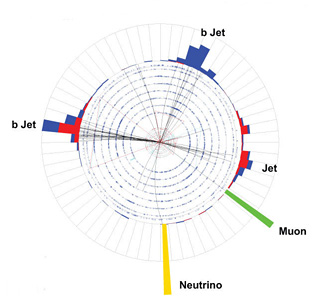 This proton-antiproton collision, recorded by the DZero collaboration, is among the single top quark candidate events. Image: DZero collaboration
This proton-antiproton collision, recorded by the DZero collaboration, is among the single top quark candidate events. Image: DZero collaboration
-
September
3
2008
Discovery of the Omegab baryon.
-
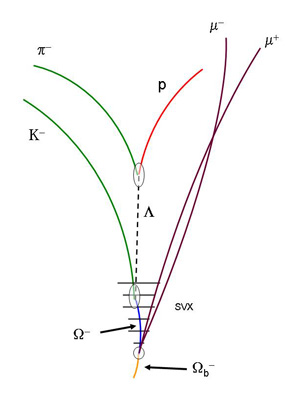 The decay pattern of the Omega-sub-b (Ωb) particle, which contains three quarks, two strange quarks and a bottom quark (s-s-b). It is an exotic relative of the much more common proton and has about six times the proton's mass. Image: Fermilab
The decay pattern of the Omega-sub-b (Ωb) particle, which contains three quarks, two strange quarks and a bottom quark (s-s-b). It is an exotic relative of the much more common proton and has about six times the proton's mass. Image: Fermilab
-
April
16
2010
Tevatron achieves a peak luminosity of 4 x 1032 cm-2 sec-1.
-
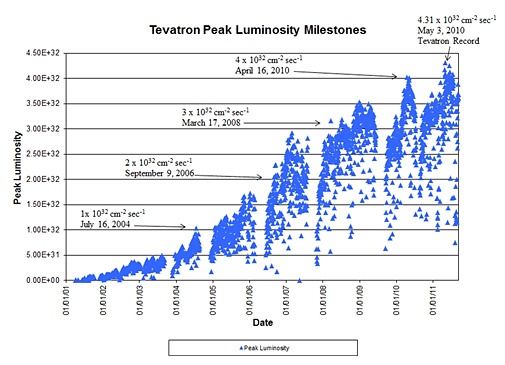 This plot shows the peak luminosity for several milestones. The Tevatron achieved a peak luminosity of 4x 1032 cm-2 sec-1 on April 16, 2010. Image: AD
This plot shows the peak luminosity for several milestones. The Tevatron achieved a peak luminosity of 4x 1032 cm-2 sec-1 on April 16, 2010. Image: AD
-
March
7
2011
Tevatron results exclude 157-173 GeV Higgs boson mass range, favoring a mass between 115-156 GeV
-
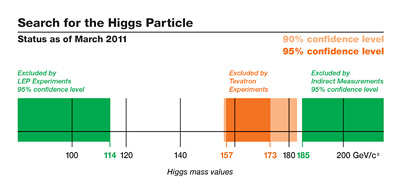 Combined CDF and DZero data, updated in 2011, excludes 157-173 GeV/c2 from the Higgs mass range. Image: Fermilab
Combined CDF and DZero data, updated in 2011, excludes 157-173 GeV/c2 from the Higgs mass range. Image: Fermilab
-
June
20
2011
Discovery of the Xib, a heavy relative of the neutron.
-
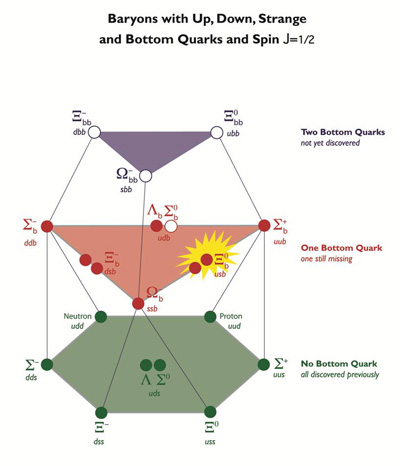 The CDF collaboration announced the discovery of the neutral Xi-sub-b (
The CDF collaboration announced the discovery of the neutral Xi-sub-b ( ) on June 20, 2011. Experiments at Fermilab's Tevatron have discovered all of the observed baryons with one bottom quark except the Lambda-sub-b, which was discovered at CERN.†Image: Fermilab
) on June 20, 2011. Experiments at Fermilab's Tevatron have discovered all of the observed baryons with one bottom quark except the Lambda-sub-b, which was discovered at CERN.†Image: Fermilab
-
September
30
2011
Tevatron produces final proton-antiproton collisions; experiments have collected about 10 inverse femtobarns of data each; data analysis will continue for several years.
Learn more(PDF)
-
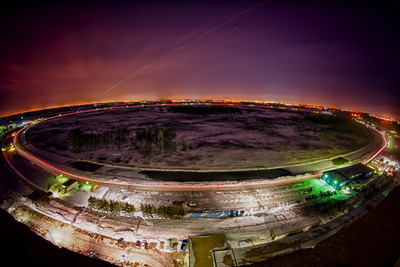 A time lapse image of the Tevatron ring, taken at night. Photo: Reidar Hahn
A time lapse image of the Tevatron ring, taken at night. Photo: Reidar Hahn
-
March
2
2012
World's best measurement of W boson mass points to Higgs mass and tests Standard Model.
-
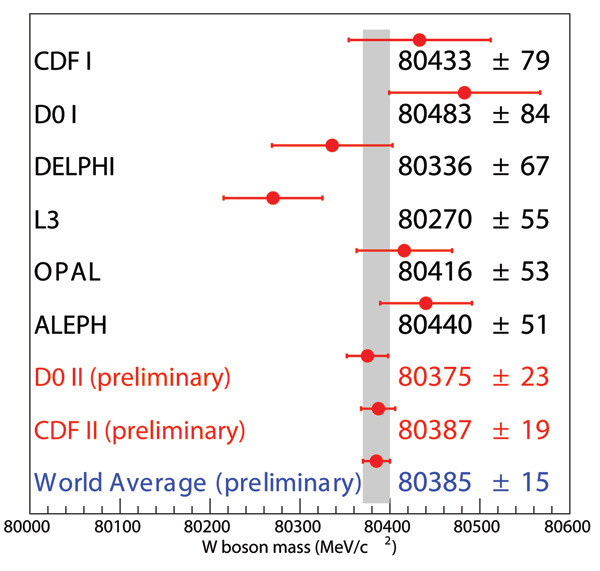
-
March
7
2012
Using different search techniques, Tevatron physicists see hints of Higgs boson sighting consistent with those from LHC.
-
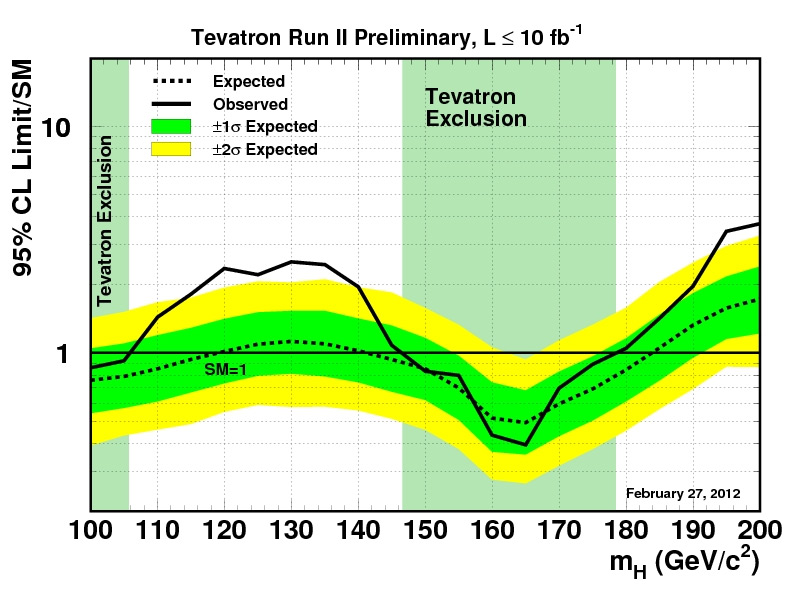
-
Looking
Ahead
Although the Tevatron shut down Sept. 30, Fermilab will continue to analyze the data it provided.
-
- Tevatron data analysis
 Fermilabís detector collaborations process their data using the Grid. Photo: Reidar Hahn
Fermilabís detector collaborations process their data using the Grid. Photo: Reidar Hahn
- IARC
 The new Illinois Accelerator Research Center, a state-of-the-art facility for research located near CDF and the Industrial Building Complex. Image: Fermilab
The new Illinois Accelerator Research Center, a state-of-the-art facility for research located near CDF and the Industrial Building Complex. Image: Fermilab
- MicroBooNE
 The MicroBooNE experiment, which will build and operate a large, approximately 100-ton, liquid Argon Time Projection Chamber (LArTPC) located along the Booster neutrino beam line, will be assembled in the DZero site building. Image: Fermilab
The MicroBooNE experiment, which will build and operate a large, approximately 100-ton, liquid Argon Time Projection Chamber (LArTPC) located along the Booster neutrino beam line, will be assembled in the DZero site building. Image: Fermilab
- Muon g-2
 Fermilabís planned g-2 experiment will use the storage ring (above) that was used in a previous muon g-2 experiment at Brookhaven National Laboratory.
Fermilabís planned g-2 experiment will use the storage ring (above) that was used in a previous muon g-2 experiment at Brookhaven National Laboratory.
- Mu2e
 The muon-to-electron conversion experiment (Mu2e) is designed to search for the coherent, neutrino-less conversion of a muon to an electron, in the Coulomb field of a nucleus. Image: Fermilab
The muon-to-electron conversion experiment (Mu2e) is designed to search for the coherent, neutrino-less conversion of a muon to an electron, in the Coulomb field of a nucleus. Image: Fermilab
- Project X
 The proposed Project X at Fermilab would provide for many research opportunities at the intensity frontier. Image: Fermilab
The proposed Project X at Fermilab would provide for many research opportunities at the intensity frontier. Image: Fermilab
- Tevatron data analysis
Early Milestones
Early events and milestones that helped make the Tevatron possible.
March 18 1983
Installation of the last of 774 superconducting dipole magnets for the Tevatron.
July 3 1983
Tevatron accelerates protons to world record energy of 512 GeV.
August 16 1983
Groundbreaking for Antiproton Source.
October 1 1983
Start of the Tevatron fixed-target program at 400 GeV with five...
February 16 1984
Acceleration of Tevatron beam to 800 GeV.
September 6 1985
Antiproton Source produces and collects first antiprotons.
October 13 1985
First observation of proton-antiproton collisions by CDF collider detector at 1.6 TeV.
May 1986
Tevatron named one of the Top Ten Engineering Achievements...
October 21 1986
Acceleration of Tevatron beam to 900 GeV.
November 30 1986
First proton-antiproton collisions at 1.8 TeV.
October 18 1989
President George Bush presents Helen Edwards, Dick Lundy, Rich Orr...
August 1991
First 8MM tape (2.5 GB) used to record data from a particle physics experiment
May 12 1992
DZero detector observes first proton-antiproton collisions.
August 31 1992
Collider Run I physics program begins with proton-antiproton collisions at 1.8 TeV
September 27 1993
Tevatron's cryogenic cooling system is named...
February 2 1995
Tevatron sets world record for number of high-energy proton-antiproton...
March 3 1995
Experimenters of the CDF and DZero collaborations announce discovery...
February 20 1996
End of Collider Run I. The Tevatron has delivered 180 inverse...
November 18 1996
Observation of antihydrogen atoms and exotic charm meson states in antiproton experiments.
August 5 1997
The Tevatron delivers a record intensity 800 GeV beam...
March 5 1998
Discovery of Bc meson, the last of the quark-antiquark pairs...
August 1998
First version of Fermi Linux, the operating system that enabled Fermilab...
March 1 1999
Fixed-target experiment KTeV observes direct CP violation in...
January 2000
End of the Tevatron fixed-target program, which provided beam...
July 20 2000
The DONuT experiment reports first evidence for the direct observation...
March 1 2001
Tevatron collider Run II begins after successful completion of...
November 7 2001
NuTeV makes precision measurements of weak interaction parameters.
July 16 2004
Tevatron achieves a peak luminosity of 1x 1032 cm-2 sec-1.
June 22 2005
FOCUS experiment completes comprehensive studies of...
July 9 2005
First observation of electron cooling of antiprotons in the Recycler Ring.
September 9 2006
Tevatron achieves a peak luminosity of 2x 1032 cm-2 sec-1.
September 25 2006
Discovery of B_s matter-antimatter oscillations: 3 trillion times per second.
October 23 2006
Discovery of Sigmab baryons...
June 2007
Discovery of the Cascade-b baryon (down-strange-bottom combination).
March 17 2008
The Tevatron achieves a peak luminosity in excess of 3 x 1032 cm-2 sec-1.
August 4 2008
Tevatron experiments start restricting the allowed Higgs mass range.
March 3 2009
World's most accurate measurement of the W boson mass...
March 9 2009
Discovery of single top quark production.
September 3 2008
Discovery of the Omegab baryon.
April 16 2010
Tevatron achieves a peak luminosity of 4x 1032 cm-2 sec-1.
March 7 2011
Tevatron results exclude 157-173 GeV Higgs boson mass range...
June 20 2011
Discovery of the Xib, a heavy relative of the neutron.
September 30 2011
Tevatron produces final proton-antiproton collisions; experiments...
March 2 2012
World's best measurement of W boson mass points to Higgs mass and tests...
March 7 2012
Using different search techniques, Tevatron physicists see hints...







